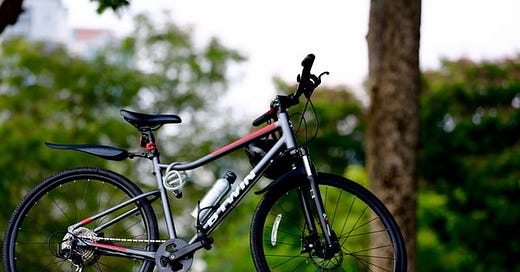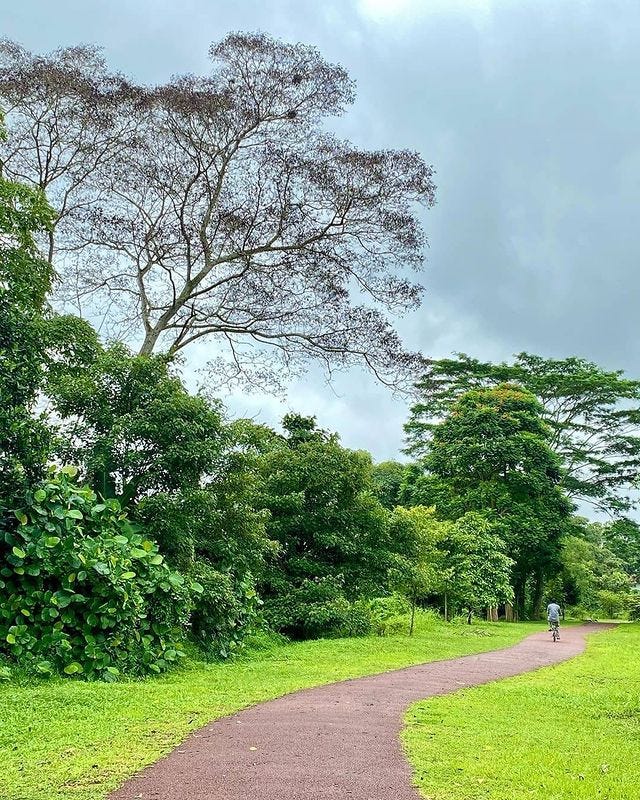5 best cycling routes in Singapore
Kamal Ishnin of The Bicycle Hut helps you cover more ground
When you think of the perfect bike ride, is this the image that comes to mind?
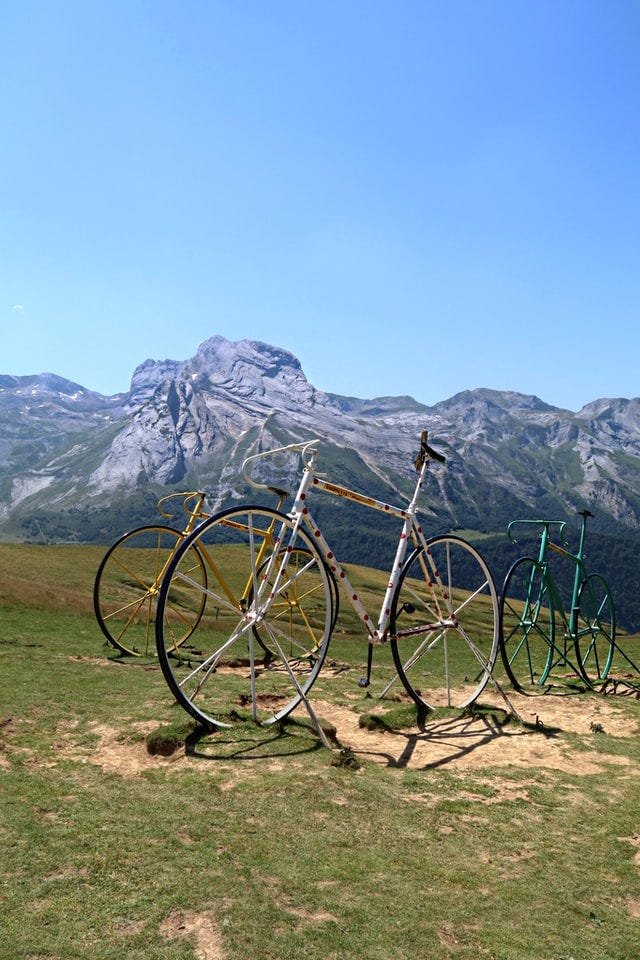
Or maybe this?
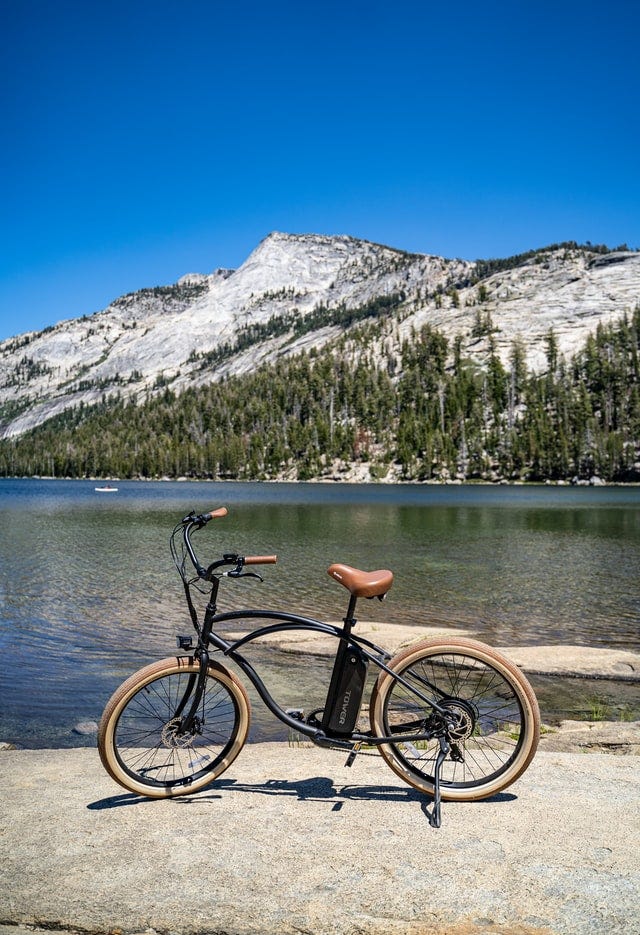
And this?
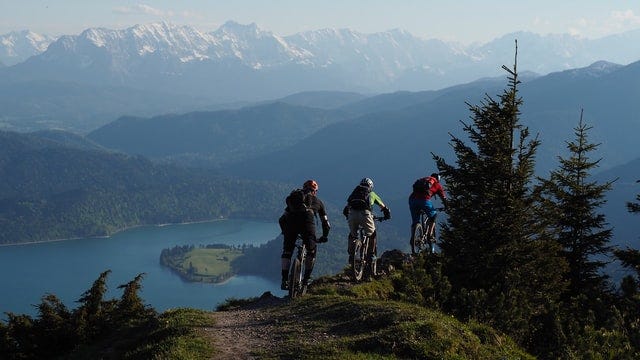
“Blue skies. A friendly cycling route with lots of things to see. Sampling good food along the way. A reasonably good bike that could include a basket, or a mountain bike or gravel bike to cover more distance. Smooth cycling, too.”
You could say this description fits the above photos to a T (minus some elements, of course, but you get the drift). The thing is, it was uttered by Kamal Ishnin, the founder of The Bicycle Hut – a bike rental shop that also offers guided cycling tours… in Singapore.
Yes – you don’t necessarily have to go to Europe to experience the perfect bike ride or cycling route, because you can find it right in your own city.
But then it also depends on what you believe to be the ideal scenario. You’re in a bustling city, after all. You won’t exactly see majestic mountains or rivers or rolling hills and plains. (Actually, you might...) Or even 100% clear roads.
There may be a few misconceptions, too-high expectations and false impressions to overcome first. “This was a typical question when we started the enterprise,” Kamal admits.
“It was a lack of understanding and fear of what you could and couldn’t do when cycling. (I’ll elaborate later on.) Until the time we entered the market, most locals generally cycled within their neighbourhood estates, and reserved their cycling to the East Coast Park and West Coast Park areas. There was this fear that cycling in the city was dangerous, and that you could seriously get injured. The locals were ‘fixated’ on looking at the beaches while cycling, when there were three times as much more to do, observe and experience in a city cycling journey. Wouldn’t you agree?”
We would, once we hear his precautions and instructions. “Cycling in European cities has been going on for at least 50 years or more. The Netherlands, Germany, Belgium, France and Switzerland have been doing this with the correct building of infrastructure,” he states.
“What’s important is to observe basic traffic rules and safety for cycling. Usually, I share my cycling experiences overseas to help dispel any fears, and liken them to our own city. A five-minute briefing of a recommended two- to three-hour cycling route with visual landmarks to observe along the way will reassure these folks of any concerns they might also have. We share images of those who have cycled with us, and the things you can experience along the way to allay any doubts.”
For example: “Some key merits of cycling include an improved heart rate, better focus, balance and deep breathing – the basis for a healthier life.”
Let’s get started then
Like right now. The Bicycle Hut promotes a range of cycling routes around Singapore that feature different stops, attractions, national parks, cityscapes and more, but customers can also request for tailored activities according to their own preferences.
Kamal shares his five favourite cycling routes in Singapore to help you feel inspired:
#1 Eastern Coastal Loop and Coney Island
Preferred bike: “Any bike type is suitable.”
“This covers the famous stretch of beach that almost all locals have cycled on. Nice stretch of park connectors that start from the Marina Bay areas and runs for 21km until you hit the newly-built Dinosaur Park located just on the borders of Changi International Airport. Scenic and windy most times, with the waves gently combing the beaches. A great stretch to cycle on weekdays when it’s quiet. Weekends are packed with picnickers and other cyclists. Overall experience: 4 stars.”
Preferred bike: “Gravel bikes, hybrids, mountain bikes.”
“Bike on the wild side in northern Singapore: Nature surrounds you, but you will never be too far from heartland neighbourhoods such as Yishun, Sembawang and Woodlands should you want to stop for a break along the way. The entire loop spans around 25km, but you can also opt for a shorter 11km route that takes you from Lower Seletar Reservoir Park to Woodlands Waterfront. Water is a major feature along this route, and you’ll pass through reservoirs, a freshwater swamp, and a jetty at Woodlands Waterfront that’s one of the longest in Singapore. The park connectors will keep you on smooth ground, but you’ll also hit some undulating terrain on your route. Keep a lookout for wildlife such as monkeys and rare birds. Overall experience: 4 stars.”
#3 The Green Corridor or Rail Corridor (85% completed)
Preferred bike: “Gravel bikes, hybrids, mountain bikes.”
“There used to be a Malaysian KTM railway line that cut through the middle of Singapore, from Woodlands Train Checkpoint to the now-defunct Tanjong Pagar Railway Station. Cyclists go on a journey through a variety of landscapes, communities and unique experiences. Enhancements will begin with Rail Corridor (Central), which is known for its lush natural landscapes and elements of rich heritage. Do take note that parts of the Green Corridor nearest to the city is still under construction as we speak. Delays due to COVID-19. Overall experience: 4 stars.”
Preferred bike: “Strictly mountain bike full suspension or hard tails.”
(*“Ketam means ‘crab’ in the colloquial Malay language. Probably so named as it’s on Ubin Island. You need to take a 20-minute bumboat ride from Changi Village to get to the island,” Kamal says.)
“Make your way to Pulau Ubin from Changi Ferry Terminal and enjoy a cycle around Ketam Mountain Bike Park. It’s the first trail in the city-state to meet international standards for mountain biking competitions, with 10km of trails that will suit cyclists of all skill levels. The three tracks have different ratings from the International Mountain Biking Association (IMBA), so go for one that corresponds with the level you’re comfortable with. If you have time, you can consider turning your bike ride into a full-day trip and discover all that Pulau Ubin has to offer. Important note: The Ketam trail is very technical and recommended only for experienced riders with proper mountain bikes. Overall experience: 5 stars.”
Preferred bike: “Gravel bikes, hybrids, mountain bikes.”
“Beginning at Chua Chu Kang, this route takes you through various parks and greenways where you’ll get up close and personal with nature. Dairy Farm Nature Park with its rugged terrain is a highlight, as are the Jurong Lake Gardens – home to the beautiful and cultural Chinese Garden and the zen Japanese Garden. This 12km route also comes with several opportunities to hop off your bike for a bit and take breaks in the tranquil and usually uncrowded surrounds. If you’re lucky, you may be able to spot one of the roughly 50 bird species that have been sighted along the Bukit Panjang Park connector. The Chinese Garden and Japanese Garden were temporarily closed due to pandemic restrictions, so check the website for updates. Overall experience: 4 stars.”
Hang on a minute
Whew. These routes sound great. Cool. Exhilarating. Exciting. I’m sure avid cyclists can’t wait to hop on their bikes and go on any one of them. It’s just that, erm, what if we haven’t cycled in a long time, and it’s only now that we’re looking at trying the activity again?
“Start with a simple and easy ride on a non-technical bike like a basic city bike,” Kamal recommends. “Build up your confidence and bike handling techniques. It would be good to have a friend join you or you could join a cycling group. Gradually increase the distance and duration of your cycling activities. Once you’ve overcome any doubts, you can hop on a bike and do that 148km-round island journey.”
Don’t forget a few important things too. “Learn how to use brakes properly and gear shifting correctly. Most mechanical faults can be avoided with the correct use of the above. Get yourself kitted with padded cycling shorts for long stretches of cycling. Invest in a helmet, some bicycle lights (front and rear), and a reliable bike lock. Bring water to hydrate yourself, and a set of Allen keys just in case you need to adjust or tighten some parts along the way.”
Now go and create your own path
Once you build up your confidence, that is. Here are a few more tips from Kamal to help you achieve just that:
#1 Beginners can start off with a two- to three-hour journey
“The route around our shop allows you to do just that with loads of ‘makan’ places to choose from. Otherwise you could pick a route from one of the five listed above. There are many more bike routes, of course. We recommend using the National Parks Boards website: Search for park connector networks and find out a list of things that you may encounter on the different routes, from biodiversity and conservation to even bicycle shops and food joints should you have a problem while cycling.”
#2 Check the schedule – and your tool kit
“Important note: Most bike shops are closed on Sundays, so it would be good if someone in the group can handle basic repairs and tube replacements. Always bring a spare bike tube, tire levers and a hand pump. Most folks choose to remain ignorant about all this and would rather pay for a tube replacement. Most tube replacements can be done under 10 minutes. If you’re lucky enough, another cyclist will be able to help you with a tube replacement, but only if you’re that lucky.”
#3 Don’t underestimate or overlook anything
“Avoid the major roads during peak hours. Pay attention to road signages and traffic regulations. All major expressways and all underground expressways are off limits to cycling. Always plan your cycling route if you are going to cycle for more than two to three hours, and check the weather forecast. The humidity can sap your energy if you are unacclimatised. Take more breaks and treat it as a picnic session on wheels.”
A cyclist’s stories
Things change, especially if you’ve been holding cycling tours with The Bicycle Hut since 2013. And it’s been interesting, to say the least.
Kamal’s observations could give you a different perspective and some insight into your cycling journey. (Besides that, they’re also good to know.)
Which way do we ride?
“As I mentioned earlier, when we started this journey, it was to change the mindset of the locals about cycling. We believed a lack of knowledge and understanding of the city areas was a key factor. Our expat communities had already been cycling in the city areas in 2013, while the locals were still cycling in the East Coast Park and West Coast Park beach areas. These locations were designated as ‘bicycle friendly’ areas by the government. It was a safe initiative, although it does have limitations. For 30 years, locals and tourists would ply the East Coast Park stretch of beach as a recreational and tourist activity. Ultimately what happens is an underappreciation of bicycles, and henceforth cycling as a whole. This suppresses creativity in cycling and the broader spectrum of cycling as an unexplored subject within tourism. Therefore, the birth of cycling tourism in Singapore. As you can see, these were all things that plagued my mind at the start. A series of actions would be required to effect some changes.”
Championing cycling
“My travels to Spain, Portugal, the Netherlands, Germany and Switzerland reaffirmed my belief that we were going the right and necessary way. There was a definite need to embark on a campaign no matter how small, and reintroduce cycling as a lifestyle. This would in turn catch fire and get support from the government in time. By reaching out to the expat communities and the tourism industry (primarily the key hotels in the city), we were able to get them to understand, support and adopt a cycling culture.
“From 2013 to 2015, our campaigns to attract and entice key hotels within the Marina Bay and Orchard Road belt by offering bike rental and bike touring services to the hotels and travel agents started to bear some results. We partnered with two other bike touring companies that were already operating in the city areas as well. The idea was to synergise a series of already-running bicycle services via a cycling hub by offering bike rentals, bike tours and short group rides (we don’t do this anymore for manpower reasons), all centred within the Marina Bay, Chinatown, Kampong Glam and Orchard Road areas. This in turn would drive businesses to hotels, food establishments and attractions that are aplenty in the city areas, thereby boosting the economy.
“At the same time, we started a small campaign on social media via Google, Facebook and Instagram to connect with expats and locals alike. We would post or share pictures of families and friends as they cycled in the city. It was an arduous process but we enjoyed every bit of it, learning from this experience and the challenges that came along with it. Rome wasn’t built in a day.”
After almost a decade
“We believe that we have succeeded in the campaign we started eight years ago. We never intended for the business to become huge (thanks to COVID-19, locals are cycling more than ever), and we still adopt a laissez-faire policy in running the business. Enter the Urban Redevelopment Authority (URA) of Singapore’s vision or Draft Master Plan 2019.
“The Master Plan is a land-use plan that serves as a blueprint to guide Singapore’s physical development. Reviewed every five years, it is a statutory plan that shows the land use and development intensity allowed for every plot of land in Singapore. In March 2019, the URA unveiled key proposals under the Draft Master Plan 2019, which outlined the strategies for Singapore’s development in the next 10 to 15 years. This included the construction of several key park connector networks that would link the entire island, and can be explored by bicycle or walking. Ding-ding!
They say timing is crucial in any endeavour. All of the above factors culminate in the growth of cycling in Singapore – a steady, constant and rapid growth.”
In the end…
“We could talk about Singapore’s past and trends, and why folks thought this way and that, but that would be best done while on a bicycle tour. Most Singaporeans from the ’50s up to the ’70s era cycled within their neighbourhood communities. The bicycle then was a means of basic transport. The nation was in its stages of infancy, gaining independence in 1965. The humble bicycle served as a part of life but not a lifestyle per se. I guess it depends on how you look at it. As public transportation improved in Singapore, the bicycle served a secondary transport role for parents to ferry their children to and from school, or for going to the nearby wet market for light grocery and household requirements. I believe it’s similar in many other countries as well, be it in Asia or Europe.”
Final thoughts (and tips)
Because it doesn’t hurt to be extra-prepared. It may spell the difference between you having a nice ride and, well, not.
“Unlike traditional bike shops, we don’t engage in retail or bike repairs. There are over 400 bike shops in Singapore, so take your pick. We could make recommendations on which local bike shop suits you best,” Kamal suggests.
“Our key focus is still cycling tourism and the promotion of cycling as a whole. We tried to link up with some eco-tourism agencies in Malaysia and Thailand in 2015, but it was too taxing and time-consuming a subject to look into with a large requirement of logistics and staff. So that has to wait awhile for now. We do a lot of thinking most times.”
And yet, “We have a variety of bicycles to rent for self-exploratory tours, and you can also join our pocket bike tours,” he reveals. “Pocket bike tours are from Wednesdays to Sundays at S$80 per person, minimum of two persons required. Bookings need to be made at least five days in advance to ensure tour guide availability. If we are not able to help you, we will refer you to the next bike touring company that is in partnership with us.”
#1 Think it through
“Plan ahead if you intend to cycle. Get as much information as you can ahead of your cycling date in unfamiliar territory. Contact the bike shop and ask for suggestions.”
#2 Choose the most suitable bike
“Take note that different bikes have different uses. Get the right type of bicycle for the right job. Some are for light cruising for a two- to three-hour journey. Others are for long-distance cycling and will cost a bit more.”
#3 Know where to get help
“At The Bicycle Hut, we make every effort to assist customers who have a bike breakdown within a 3km radius (within half an hour) of the shop, although that may not be possible on busy weekends and holidays. If you are planning to cycle long journeys, say beyond 20km, be prepared to contact a bicycle transport company to assist you if you have a breakdown. You can use Gogovan or Lalamove to help you with this. They’re like Uber and Grab but for transporting goods and services, and most times they can pick you up within 30 minutes of booking. If you are more than 10km away with a breakdown, then use Gogovan. Good thing is, breakdowns are rare and usually tube punctures.” We can rest easy and just enjoy the experience then.
Find The Bicycle Hut at 1 North Bridge Road, High Street Centre, #B1-53, Singapore 179094, tel: +65 6635 8353, and on Facebook and Instagram.
The Bicycle Hut also has corporate clients (like airlines) – with annual payments and packages, they can furnish your team with bikes for cycling as a way to exercise and de-stress from a hard day’s work.

